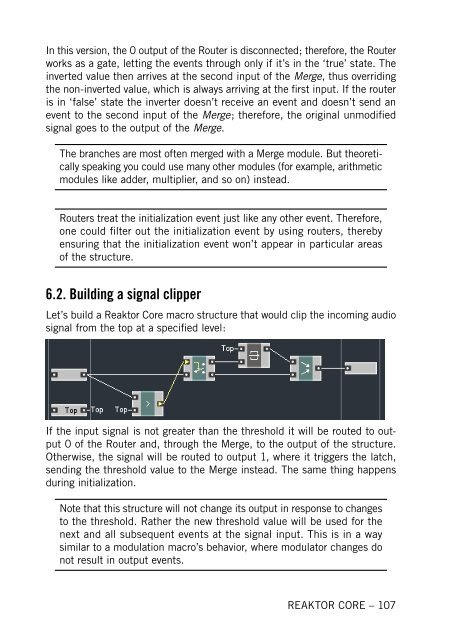1. First steps in Reaktor Core - Native Instruments
1. First steps in Reaktor Core - Native Instruments
1. First steps in Reaktor Core - Native Instruments
You also want an ePaper? Increase the reach of your titles
YUMPU automatically turns print PDFs into web optimized ePapers that Google loves.
In this version, the 0 output of the Router is disconnected; therefore, the Router<br />
works as a gate, lett<strong>in</strong>g the events through only if it’s <strong>in</strong> the ‘true’ state. The<br />
<strong>in</strong>verted value then arrives at the second <strong>in</strong>put of the Merge, thus overrid<strong>in</strong>g<br />
the non-<strong>in</strong>verted value, which is always arriv<strong>in</strong>g at the first <strong>in</strong>put. If the router<br />
is <strong>in</strong> ‘false’ state the <strong>in</strong>verter doesn’t receive an event and doesn’t send an<br />
event to the second <strong>in</strong>put of the Merge; therefore, the orig<strong>in</strong>al unmodified<br />
signal goes to the output of the Merge.<br />
The branches are most often merged with a Merge module. But theoretically<br />
speak<strong>in</strong>g you could use many other modules (for example, arithmetic<br />
modules like adder, multiplier, and so on) <strong>in</strong>stead.<br />
Routers treat the <strong>in</strong>itialization event just like any other event. Therefore,<br />
one could filter out the <strong>in</strong>itialization event by us<strong>in</strong>g routers, thereby<br />
ensur<strong>in</strong>g that the <strong>in</strong>itialization event won’t appear <strong>in</strong> particular areas<br />
of the structure.<br />
6.2. Build<strong>in</strong>g a signal clipper<br />
Let’s build a <strong>Reaktor</strong> <strong>Core</strong> macro structure that would clip the <strong>in</strong>com<strong>in</strong>g audio<br />
signal from the top at a specified level:<br />
If the <strong>in</strong>put signal is not greater than the threshold it will be routed to output<br />
0 of the Router and, through the Merge, to the output of the structure.<br />
Otherwise, the signal will be routed to output 1, where it triggers the latch,<br />
send<strong>in</strong>g the threshold value to the Merge <strong>in</strong>stead. The same th<strong>in</strong>g happens<br />
dur<strong>in</strong>g <strong>in</strong>itialization.<br />
Note that this structure will not change its output <strong>in</strong> response to changes<br />
to the threshold. Rather the new threshold value will be used for the<br />
next and all subsequent events at the signal <strong>in</strong>put. This is <strong>in</strong> a way<br />
similar to a modulation macro’s behavior, where modulator changes do<br />
not result <strong>in</strong> output events.<br />
REAKTOR CORE – 107










